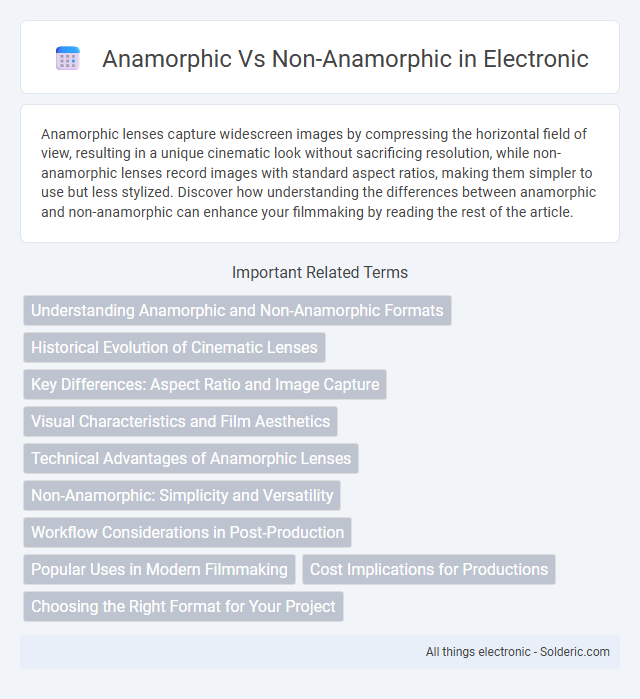Anamorphic lenses capture widescreen images by compressing the horizontal field of view, resulting in a unique cinematic look without sacrificing resolution, while non-anamorphic lenses record images with standard aspect ratios, making them simpler to use but less stylized. Discover how understanding the differences between anamorphic and non-anamorphic can enhance your filmmaking by reading the rest of the article.
Comparison Table
| Feature | Anamorphic | Non-Anamorphic |
|---|---|---|
| Aspect Ratio | Wider aspect ratio (typically 2.39:1) | Standard aspect ratio (commonly 1.85:1 or 16:9) |
| Lens Design | Special lens squeezes image horizontally during recording | No image compression, captures image as-is |
| Image Quality | Maximizes sensor resolution horizontally for widescreen | Resolves image at native sensor dimensions |
| Usage | Cinema, widescreen film productions | TV, standard video, web content |
| Post-Production | Requires de-squeezing to restore correct proportions | No de-squeezing needed |
| File Size | Efficient bandwidth for widescreen formats | Standard file sizes based on resolution |
Understanding Anamorphic and Non-Anamorphic Formats
Anamorphic format uses lenses to compress a wider field of view onto a standard sensor or film, enabling widescreen images without sacrificing resolution. Non-anamorphic format captures images using the full sensor area, resulting in a natural aspect ratio but often requiring cropping or letterboxing for widescreen display. Understanding the key differences helps filmmakers choose the right technique for preserving image quality and achieving desired cinematic effects.
Historical Evolution of Cinematic Lenses
Anamorphic lenses emerged in the 1950s to create widescreen images by horizontally squeezing the film image, allowing filmmakers to capture expansive scenes without compromising image quality, while non-anamorphic lenses maintained the standard aspect ratio. The historical evolution of cinematic lenses showcases a shift from bulky, specialized anamorphic designs toward versatile, high-quality lenses that balance optical distortion with creative control. Your choice between anamorphic and non-anamorphic lenses impacts the cinematic style, influencing factors such as aspect ratio, bokeh, and lens flare characteristics in film production.
Key Differences: Aspect Ratio and Image Capture
Anamorphic lenses capture a wider aspect ratio by horizontally squeezing the image onto standard film or sensor, effectively recording more horizontal information without cropping. Non-anamorphic lenses record images in their native aspect ratio, resulting in a standard frame without distortion but with less horizontal field of view. The key difference lies in how anamorphic lenses manipulate image capture to achieve cinematic widescreen formats, while non-anamorphic lenses produce conventional, unsqueezed images.
Visual Characteristics and Film Aesthetics
Anamorphic lenses create a distinctive cinematic look with an ultra-wide aspect ratio and oval-shaped bokeh, enhancing visual storytelling through stretched horizontal fields and lens flares. Non-anamorphic lenses produce images with natural proportions and round bokeh, often resulting in cleaner, more neutral aesthetics without the signature distortion effects. The choice between anamorphic and non-anamorphic influences film aesthetics by balancing immersive widescreen visuals and stylistic depth against clarity and simplicity in composition.
Technical Advantages of Anamorphic Lenses
Anamorphic lenses provide a wider field of view by squeezing a broader image onto the camera sensor, effectively capturing more horizontal information without sacrificing resolution. These lenses create distinctive optical characteristics such as oval bokeh and horizontal lens flares, enhancing cinematic aesthetics. Their ability to maximize sensor usage improves image quality while maintaining high resolution and minimizing distortion compared to non-anamorphic lenses.
Non-Anamorphic: Simplicity and Versatility
Non-anamorphic lenses offer simplicity and versatility by capturing images without horizontal compression, making them compatible with standard editing software and playback devices. Your workflow benefits from easier handling and reduced need for specialized equipment, ideal for versatile shooting scenarios. These lenses deliver consistent results across various formats, enhancing adaptability in diverse production environments.
Workflow Considerations in Post-Production
Anamorphic footage requires specialized post-production workflows, including specific de-squeeze settings to restore the intended aspect ratio and careful attention to lens distortion and bokeh characteristics. Non-anamorphic footage follows more straightforward editing processes, often allowing for standard scaling and cropping without complex adjustments. Your choice between anamorphic and non-anamorphic influences color grading, VFX integration, and final output resolution, making workflow planning essential for efficient post-production.
Popular Uses in Modern Filmmaking
Anamorphic lenses are popular in modern filmmaking for creating cinematic widescreen visuals with unique lens flares and shallow depth of field, often used in high-budget films and commercials. Non-anamorphic lenses remain favored for their versatility and ease of use, making them common in documentaries, TV shows, and indie projects. Your choice between anamorphic and non-anamorphic lenses impacts the aspect ratio, image style, and post-production workflow.
Cost Implications for Productions
Anamorphic lenses often come with higher rental or purchase costs compared to non-anamorphic lenses, impacting production budgets significantly. The unique optical design and specialized equipment required for anamorphic shooting and post-production contribute to increased expenses. Your production should carefully weigh the artistic benefits of anamorphic aesthetics against these added financial considerations.
Choosing the Right Format for Your Project
Choosing between anamorphic and non-anamorphic formats depends on your project's visual goals and technical requirements. Anamorphic lenses capture a wider aspect ratio with unique lens flares and shallow depth of field, ideal for cinematic storytelling and high-impact visuals. Your decision should consider the final display medium, budget constraints, and post-production workflow to ensure optimal image quality and creative expression.
Anamorphic vs Non-Anamorphic Infographic

 solderic.com
solderic.com